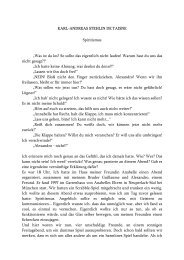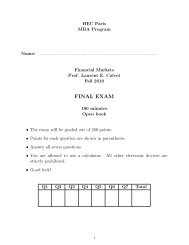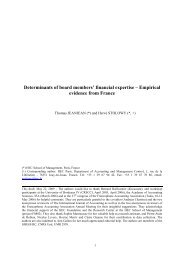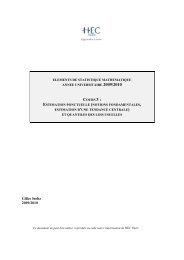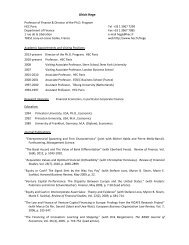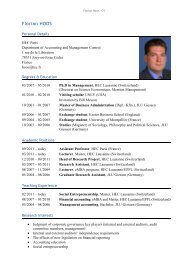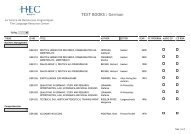Multifractality of US Dollar/Deutsche Mark Exchange Rates - Studies2
Multifractality of US Dollar/Deutsche Mark Exchange Rates - Studies2
Multifractality of US Dollar/Deutsche Mark Exchange Rates - Studies2
You also want an ePaper? Increase the reach of your titles
YUMPU automatically turns print PDFs into web optimized ePapers that Google loves.
6 GARCH and FIGARCH Alternatives<br />
This section simulates data from GARCH and FIGARCH representations. The parameter values<br />
come from previously published research on foreign exchange data. We find that these processes<br />
are distinct from the MMAR under simulation, and that the scaling properties <strong>of</strong> the DM/<strong>US</strong>D<br />
data are more consistent with the MMAR.<br />
6.1 GARCH<br />
Weak memory in GARCH has recently become interesting to researchers. Taylor (1986), Dacorogna<br />
et al. (1993), Baillie (1996), and others note that many financial time series display hyperbolically<br />
declining sample autocorrelation functions. In contrast, the GARCH decay rate is exponential.<br />
This finding is not a technicality or a matter <strong>of</strong> moment fitting, but has important qualitative<br />
implications. For example, under certain regularity conditions rescaled weak memory processes<br />
weakly converge to Brownian Motion. 34 This can be depicted visually.<br />
Four GARCH(1,1) simulations, with parameters from Baillie and Bollerslev (1989), appear in<br />
Figure 17. The parameter values cover a typical range for GARCH(1,1) estimated on daily and<br />
weekly data. The plots contain 40, 000 observations in order to show low frequency effects clearly.<br />
Convergence to Gaussian is apparent in 17a-c. The occasional spikes do not cluster except at high<br />
frequencies, and thus their contribution is washed out over long intervals.<br />
Figure 17d is different. The parameter values used in this simulation are {α1,β1} = {.072,.923},<br />
which very nearly sum to one. Thus, squared returns are nearly integrated, or IGARCH, explaining<br />
noticeable low frequency effects. Still, the variations in volatility appear very unnatural, lacking<br />
significant high frequency variation. 35 Because weak-memory, even near integration, in volatility<br />
appears inconsistent with the data, we predict that GARCH will not replicate scaling patterns<br />
found in the data.<br />
Expectations for the GARCH partition function are not easily calculated, so simulation is<br />
our main tool. 36 Partition functions <strong>of</strong> the previous simulations appear in Figure 18. None is<br />
34 This is a generalization <strong>of</strong> Donsker’s Theorem, which concerns the weak convergence <strong>of</strong> random walks. Intuitively,<br />
the claim is also related to Central Limit Theorems for weakly dependent sequences.<br />
35 In this paper,“high frequency” should be interpreted relative to the scale <strong>of</strong> the graph or data.<br />
36 For general GARCH(q,p) processes, E [Sq(△t)] is a complicated expression in combinatorial sums. As △t →∞,<br />
we expect GARCH to scale like Brownian Motion, since very large increments are approximately Gaussian with<br />
negligible dependence.<br />
25



